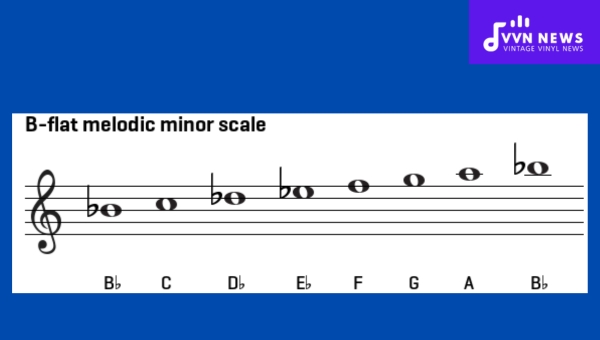If you’re diving into music theory or seeking to broaden your musical knowledge, scales are crucial. One such scale that holds a significant place in the melodic framework is the B flat melodic minor scale.
It might seem daunting at first glance, but once unraveled, it reveals a beautiful sequence of notes that can take your music composition and appreciation to a whole new level.
When one thinks of minor scales, emotions – sad, reflective, and soul-stirring- generally come to mind.
Within this emotional landscape lies an expansive gamut of scales. The B flat melodic minor Scale brings an intriguing balance of vibrant melodies with melancholic undertones, certainly making it a fascinating subject for budding musicians and seasoned pros alike.
Components of Intervals in B Flat Melodic Minor Scale
To grasp the beauty of the B Flat Melodic Minor Scale, we must explore its constituent intervals. Here’s a list of each interval within this scale:
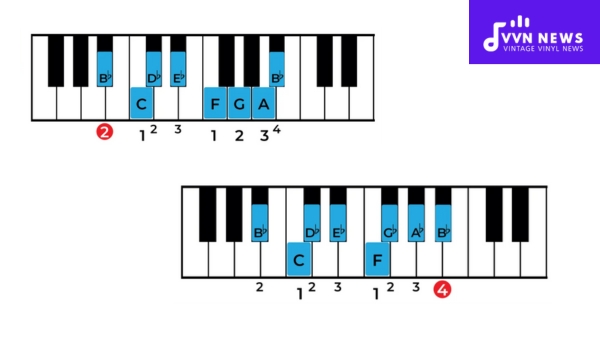
- Tonic: This is our starting point, the note B flat.
- Major Second: Next up is C.
- Minor Third: The third note is D flat.
- Perfect Fourth: Our fourth stepping stone lands on E flat.
- Perfect Fifth: F trails close behind as our fifth note.
- Major Sixth: The sixth step brings us to G.
- Major Seventh: A natural occupies the seventh place.
- Octave: We circle back to our tonic, B flat, wrapping up the octave.
The structure comprises seven unique notes with an eight-note completing the octave – a musical journey that begins and ends with B Flat, offering a gorgeous progression in the keys of music.
Each interval has a role to play in weaving together this appealing melody, creating a musical tapestry that is irresistible to ears trained to appreciate the intrinsics of sound arrangement.
The Fundamental Formula of a Melodic Minor Scale
This melodic minor scale is constructed with a specific formula of whole steps (W) and half steps (H). In ascending order, it follows W-H-W-W-W-W-H. This distinct pattern is what sets the melodic minor scale apart.
For instance, in the B Flat melodic minor scale, starting from the B flat note, we would follow this exact pattern to find the other notes in the scale.
The uniqueness of this construct becomes even more pronounced when we explore the descending order of notes which essentially flips and becomes equivalent to a natural minor scale.
It’s a fascinating play between half-steps and whole-steps that brings out the lyrical pathway of minor melodies.
Ascending Notes in B Flat Melodic Minor Scale
When it comes to the B flat melodic minor scale we encounter a specific sequence of notes during ascent. Intriguingly, these notes change from a typical minor scale format, incorporating brighter-sounding tones mainly in 6th and 7th degrees.
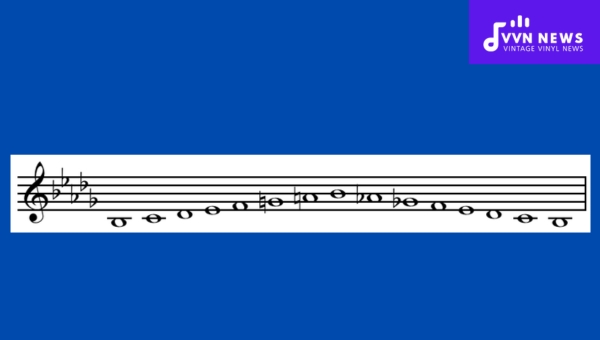
Let’s explore the ascending arrangement:
- 1st degree – Root/Tonic – Bb: This is our keynote around which other notes pivot.
- 2nd degree – Supertonic – C: Adds depth following the root note.
- 3rd degree – Mediant – Db: Dubbed as the ‘median’ between tonic and dominant.
- 4th degree – Subdominant – Eb: This is halfway along the seven-note sequence.
- 5th degree – Dominant – F: An essential chord in constructing triads.
- 6th degree – Submediant – G and 7th degree – Leading Note – A: Here lies the distinction. In a natural or harmonic minor scale, these would be Ab and Bb respectively, but with melodic minor scales, we see them raised a half-step during the ascent.
- Finally returning to Root/Tonic – Bb, marking an octave’s completion.
It’s not just about learning pitches but how they harmonize together. This can add immense sophistication to your musical compositions or improvisations.
Next time you sit down at the piano or grab your guitar, challenge yourself to work through this scale.
As you familiarize yourself with its unique tonal mood, you’ll discover a world of new melodic possibilities within your music-making journey.
Also Read: Phrygian Mode [Adding Exotic Flair To Your Musical Compositions]
Notes in descending B Flat melodic minor scale?
In contrast to the ascending order of the B Flat melodic minor scale, the descending notes present a different configuration.
This is what separates the melodic minor scale from other minor scales: the descending motion follows the natural minor scale.
Therefore, rather than retracing your steps back down from B flat to B flat, you enter new harmonic territory.
From top to bottom, our structure looks like this:
- 1st degree – root/tonic – Bb: This is our starting point again in descent.
- 7th degree – leading note – Ab: But immediately we deviate from the melodic norm.
- 6th degree – submediant – Gb: This symbolizes emotional abundance.
- 5th degree – dominant – F: Here stability is found.
- 4th degree – subdominant – Eb: Offers a change of pace.
- 3rd degree – mediant – Db: Adds intrigue with a touch of melancholy.
- 2nd degree – supertonic – C: The penultimate step breathes light onto the scene before returning once again to the root or tonic.
Herein lies a fascinating aspect of music theory: melodic construction isn’t linear. It’s full of twists and turns that make it more engaging and captivating.
The descending sequence of musical notes offers unique melodies that weave diverse tapestries within your musical compositions.
It takes your audience on a distinctive harmonic journey, seamlessly flowing through emotions but always drawing them back to their point of origin.
Also Read: E Minor Pentatonic Scale [How To Use In Your Music Composition]
How to Play B Flat Melodic Minor on Different Instruments?
Playing the B flat melodic minor scale on any instrument takes practice and a proper understanding of music theory.
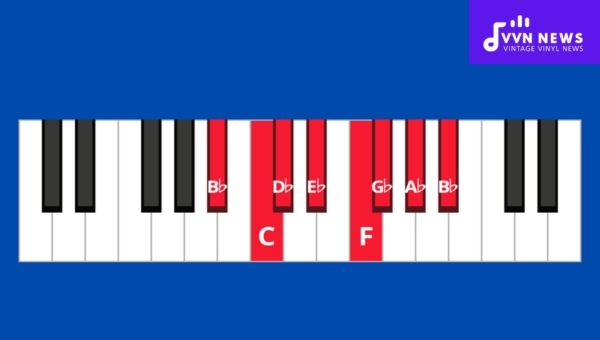
The scale comprises eight notes, with different pitches, which escalate when you play it ascending and diverge when descending.
Playing the B Flat Melodic Minor on the Guitar
The B flat melodic minor scale, like any other scale, offers distinctive notes and tonal charms. Here’s how you can tune your guitar to play this enriching scale:
- Tune the lowest (sixth) string to B flat
- Make your way to E flat by pressing down the sixth string at the first fret
- The fourth string open will give out D
- To achieve F, press the same string at the third fret
- Next is G; press down the third string to open
- For A, touch this same string at the second fret
- Lastly, B (a high octave) – achieve it through opening up on the second string
Try practicing these series of notes until you are comfortable with them.
Guideline to Play B Flat Melodic Minor on Piano
Getting hold of the B flat melodic minor scale on piano requires navigation around white and black keys.
- Start off with “B Flat”, which is the black key right after A.
- Continue to “C”, just two white keys down.
- Move ahead towards “D”, i.e., two white keys forward.
- “E Flat” comes next; it’s a black key following D.
- Jump straight to “F”; you’ll find precisely two white keys after E flat.
6 & 7: Scale further towards “G” & “A”. These are back-to-back white keys neighboring F. - At last, comes another “B Flat” correspondent octave higher than we first kicked off from.
Whether it be guitar or piano, mastery over scales doesn’t come overnight—it takes practice and perseverance.
Also Read: A Guide Transposing Into The Alto C [Navigate Music Transposition]
What’s the key signature for B Flat melodic minor?
The key signature for the B flat melodic minor scale consists of two flats: B flat (Bb) and E flat (Eb).
When notating this scale, these flats are placed at the beginning of each line on the stave.
We must remember that, in the ascending form of this melodic minor scale, the 6th and 7th notes are raised by a half step.
This leads to the temporary displacement of these two flats from their original position and makes the key signature appear as if there are no flats or sharps.
But don’t be misled; it remains in essence – ‘two flats’ – B flat and E flat. It’s this musical intrigue that adds spice to your composition using the alluring B Flat Melodic Minor Scale!
B Flat melodic minor in different musical clefs?
The appreciation of a scale transcends memorizing it. An important aspect of this comprehension includes being able to recognize it in different musical clefs.
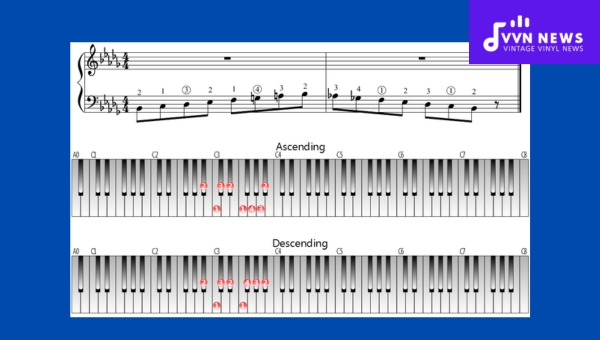
This is exceedingly essential as it enhances the overall adaptability and versatility of the musician. The B flat melodic minor scale reveals its unique characteristics in each different clef, thereby necessitating an exploration.
Treble Clef
Let’s begin with the most common clef, also referred to as the G clef, which is frequently used for high-pitched instruments like flute, violin, or guitar.
The B flat melodic minor scale constitutes seven ascending notes: B-flat, C, D-flat, E-flat, F, G, and A.
For descending notes in treble clef, you simply follow the order from high to low: B flat, A flat, G flat, F flat E flat D flat, and C.
Bass Clef
In contrast to the treble clef that covers higher-pitched instruments the Bass Clef or F clef typically corresponds with lower-pitched instruments such as bassoon cello double bass and tuba.
Here too our ascending series remains unchanged while the descending one mirrors its treble equivalent line for line.
Alto Clef
Simultaneously obscure yet significant for specific instrument players namely viola viola da gamba alto trombone etc., lies the Middle C or Alto Clef.
Functionally it falls between Treble and Bass marking middle C right on its centerline.
Initially, it might seem intimidating but once accustomed it can provide a more balanced look particularly when dealing with a mid-range instrument neglecting any extreme on ledger lines.
Once this interchangeability among clefs has been mastered it would not only help in diversifying one’s own compositions but also provide a richer sense of appreciation towards the bewitching sequences of the B flat melodic minor scale.
What chords are part of B Flat melodic minor?
Exploring the chords within the B Flat melodic minor, we find a mix of major, minor, and diminished types. Specifically, these chords are:
- Bb minor or B♭-Maj
- C minor or Cmin
- D diminished or Ddim
- Eb Major or E♭-Maj
- F Major or F-Maj
- G minor or Gmin
- A diminished or Adim
These chords form an integral part of this melodic scale—a helpful aspect when you’re composing pieces in this key signature!
Familiarizing yourself with each chord can greatly assist your creativity while composing music, ensuring smooth transitions and balanced harmonies.
Jazz Style B Flat Melodic Minor Scale
The B flat melodic minor scale has a unique influence on the Jazz genre. Often referred to as the ‘Jazz Minor Scale’, it opens an expanse of light and shade in the color palette of Jazz music.
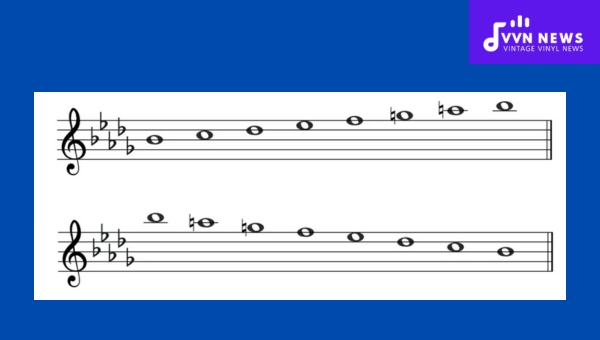
In addition, its raised 6th and 7th notes allow for richer harmonic possibilities, fitting perfectly into the expressive, flowing improvisation vibe of this genre.
When played over a minor chord, it adds intensity and emotional depth. Meanwhile, over dominant chords, the scale can create an interesting altered dominant sound.
For jazz musicians looking to add more variety to their solos or compositions, venturing into this scale could be rewarding.
Also Read: Mastering Chords In A Minor [Improve Your Composition Skills]
FAQs
What is the unique feature of the B flat melodic minor scale?
The B flat melodic minor scale has an interesting characteristic – it ascends in one way and descends differently which sets it apart from other scales.
Can I play B flat melodic minor Scale on any instrument?
Yes, the B flat melodic minor Scale isn’t limited to a specific instrument. You can play this Scale on any tuned musical instrument like piano, guitar, violin, etc.
Is the B Flat melodic minor scale common in modern music?
While it might not be as prevalent as major scales, the B Flat melodic minor does make appearances in various music genres, including jazz and classical compositions.
How does the B Flat Melodic Minor benefit me as a musician?
It broadens your appreciation of music theory, enhances your versatility in composing music, and adds depth to your improvisation abilities during performances.
What are some popular songs that use the B Flat Melodic Minor scale?
While it’s hard to list all, you can find this scale being used in compositions by classical composers like Bach and Beethoven. It also occasionally shows up in jazz and rock music.
Conclusion
The B flat melodic minor scale offers a smorgasbord of enriching musical possibilities. From its noteworthy sequence of intervals to its unique ascending and descending pitches, mastering this scale can elevate your musical prowess.
If you’re playing the piano, guitar, or any instrument of your choice, that practice is the key to mastery. The beauty of this scale lies in its balance between melody and melancholy.
So, go ahead, embrace the depth of B flat melodic minor, and add a new dimension to your music repertoire.
